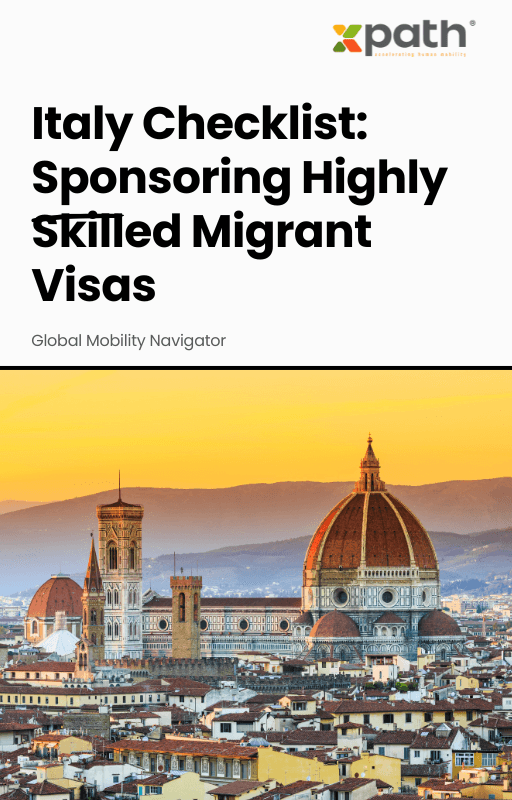Italy Checklist: Sponsoring Highly Skilled Migrant Visas
Grab a copy of a guide to international employee relocation
View E-bookToday, employee relocation isn’t just about packing up and heading off to a new country. It’s a high-stakes, highly strategic process, especially when it comes to cross-border mobility between EU and non-EU countries. Companies are now playing a complex game — navigating legal hurdles, balancing cost efficiency, and ensuring employee satisfaction — all while keeping their global workforce agile and compliant. If you’re leading HR, building a fast-growing startup, or simply curious about how businesses keep talent mobile across borders, this guide is for you.
Cross-border mobility has become more than just a corporate benefit; it’s a critical driver of growth and innovation. In the last decade, global talent flows increased dramatically, with Global Mobility Trends Surveys noting that 39% of multinational companies expect their international assignee numbers to grow annually. With the EU’s freedom of movement contrasted against tighter controls in non-EU countries, there’s a delicate dance between opportunity and restriction. As companies look to access wider talent pools, understanding the unique challenges and opportunities of EU to non-EU mobility becomes crucial.
The European Union offers relative ease of movement among member states, thanks to the Schengen agreement and harmonized visa regulations. For employees shuttling between Paris and Berlin, or Madrid and Amsterdam, the process is streamlined. But throw a non-EU destination — say, London or New York — into the mix, and suddenly mobility requires navigating a maze of visas, work permits, and compliance documentation.
According to the Worldwide ERC, regulatory compliance is now considered the top challenge in cross-border assignments. Changing immigration laws, the impact of Brexit on EU-UK business, and shifting tax regulations all create significant roadblocks. For HR teams, ensuring that every employee is not only permitted to work abroad, but also shielded from legal pitfalls, can feel like trying to hit a moving target.
Consider the real-life example of an international tech firm headquartered in Munich. When the company sought to relocate key developers to its Dublin and London offices, the process within the EU was fast and relatively pain-free. However, for their London placements, post-Brexit immigration controls led to visa delays exceeding 3 months — stalling project launches and driving up costs. In response, this firm turned to technology-driven global mobility solutions, like those provided by xpath.global, to streamline tracking, compliance, and documentation. By centralizing assignee information and automating paperwork, they shaved weeks off the process and gained real-time visibility into their cross-border moves.
When orchestrating cross-border mobility between EU and non-EU nations, companies face three mammoth hurdles: compliance, cost, and culture. Navigating immigration requirements (which can change overnight), staying ahead of shifting tax liabilities, and managing GDPR mandates can quickly spiral into a compliance nightmare. Then there’s the financial side; a single failed relocation may cost upwards of $75,000, according to SHRM research, factoring in legal fees, lost productivity, and support services.
But challenges aren’t just legal and financial. Employees often face culture shock, language barriers, and social integration hurdles – all of which can sink morale and lead to assignment failure. It’s no wonder that Deloitte reports only 42% of international relocations globally are rated as fully successful by employers.
The good news? Data-driven global mobility solutions are making life infinitely easier for companies and their employees. Platforms like xpath.global offer centralized dashboards for immigration, tax, and compliance, automating everything from document uploads to deadline reminders. With 24/7 tracking and robust analytics, organizations can now make informed relocation decisions, predict potential problems, and pivot quickly when regulations change.
Recent industry studies show that companies deploying digital mobility solutions see a 30% reduction in relocation processing times and up to 20% savings on administrative costs. The ability to consolidate vendors, workflows, and data into a single cloud-based platform also means greater transparency, fewer errors, and a more human-centric experience for assignees.
Looking forward, cross-border mobility between EU and non-EU territories will demand even more agility and expertise. Whether it’s handling the fallout from evolving trade agreements, navigating remote work tax challenges, or keeping pace with immigration reforms, the right global mobility strategy is non-negotiable. Companies must invest in robust digital tools, cultivate partnerships with local experts, and embed flexibility into every step of the mobility process.
Ready to turn daunting obstacles into growth opportunities? The secret sauce is combining technology-driven platforms like xpath.global with a deep understanding of local regulations and a relentless focus on employee experience. That’s how modern businesses win the cross-border talent game.
What are the key differences between relocating within the EU and to/from non-EU countries?
Relocations within the EU often benefit from freedom of movement, making visas and permits less complicated. Moving to or from non-EU countries requires in-depth immigration procedures, extra documentation, and compliance checks.
Why is compliance so challenging in cross-border mobility?
Every country has its own set of laws regarding visas, taxes, and employment — and these can change suddenly. Keeping up with multi-country requirements is complex and can expose companies to fines or bans if mishandled.
How can technology help HR manage global mobility?
Technology centralizes all mobility information, automates paperwork, tracks deadlines, and provides visibility into every step of the relocation journey, which reduces processing times and minimizes errors.
Is using a global mobility platform expensive?
While there’s an initial investment, the time and cost savings realized from streamlined processes, reduced errors, and data-driven decision-making usually result in significant ROI, especially for companies with frequent cross-border moves.
Ready to transform your mobility program? Explore xpath.global’s solutions.

Italy Checklist: Sponsoring Highly Skilled Migrant Visas
Grab a copy of a guide to international employee relocation
View E-book